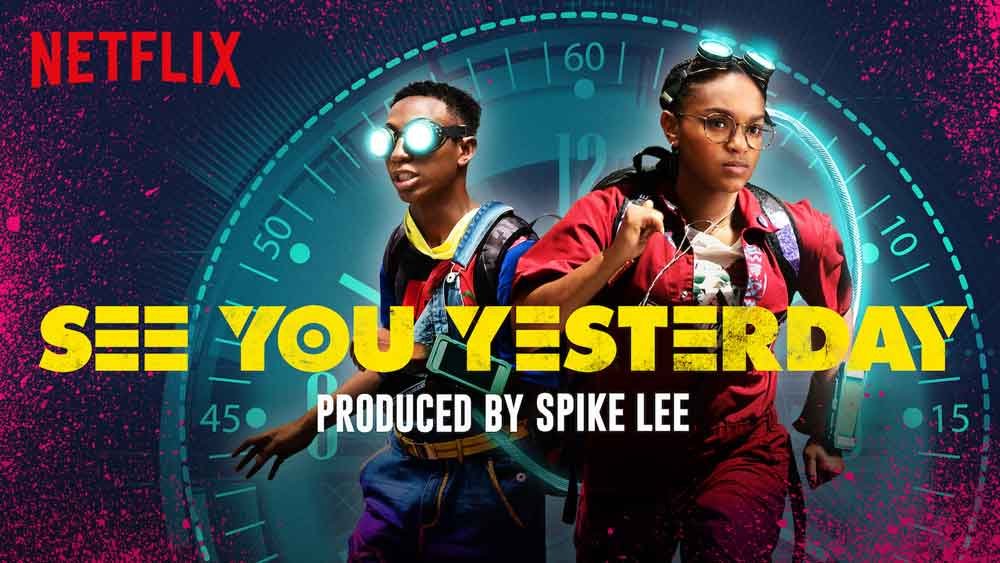
REVIEW: See You Yesterday
- May 27, 2019
- by
- Ivan Moore
What is it about time travel that brings storytellers back to the concept again and again? There have been countless movies, TV shows, comics, books, and songs (Cher’s “If I Could Turn Back Time” anyone?) inspired by it. Perhaps the biggest movie ever made, Avengers: Endgame, revolves around going backwards through time. Yet, so much of what we know about time travel stems from one source, Marty McFly, Doc Brown, and their flying DeLorean. Paul Rudd’s Ant Man lays out the rules of time travel in Endgame warning that his Avengers teammates need to be careful they don’t talk to their past selves or bet on sporting events, all references to 1985’s Back to the Future.
That singular movie has shaped so much of what popular culture thinks about time travel and has inspired other contributions to the culture as well. Rick & Morty, a cartoon loosely inspired by Doc and Marty, has gathered an enthusiastic, albeit occasionally problematic, fan base. This year Nike debuted its third major attempt at recreating the sequel’s famous self-lacing sneakers. The Nike BB Adapt will even be seen in a Back to the Future II colorway this year! Don’t forget our recent obsession with “hoverboards” and geocache scooters that have us all feeling McFly on the sidewalks. What about time travel itself, though? Why are we so drawn to the ideas explored in Robert Zemeckis’s landmark film?
In the Netflix movie, See You Yesterday, a delightful cameo states, “If time travel were possible, it would be the greatest ethical and philosophical conundrum of the modern age.” This character, whom I’ll keep a surprise, goes on to ask, “If you had that kind of power, what would you do? What would you change?” There lies the magic of this classic sci-fi scenario. Time travel offers audiences the opportunity to dream about what could be, and the continued allure of Back to the Future may be in just how simple the film makes it look to change everything. Marty pinpoints all of his family’s troubles down to one moment from his parents’ past and it causes a butterfly effect that improves life for every McFly. It’s that easy. Marty wakes up at the end of the film and his parents are more in love than ever, his siblings are more professionally successful, Marty gets the girl and the cool car he could never afford, and, in general his family is more affluent. What if it was more complex than that? What if the issues holding you back reached farther and deeper than one specific moment?
See You Yesterday follows teenage prodigies CJ and Sebastian, students at a New York science-focused high school. They are so brilliant that years before Tony Stark could, they’ve figured out time travel! In their first successful test, CJ inadvertently causes a ripple that leads to tragedy. In the wake of her mistake, someone attempts to comfort CJ by saying that we all wish we had the power to go back and change things. CJ and Sebastian have that power and are launched into a race against time to fix everything! It doesn’t take very long before CJ realizes she isn’t in Back to the Future, and that changing the world isn’t as simple as Doc and Marty have led us to believe.
Here is where See You Yesterday shines. Writer/director Stefon Bristol uses time travel to explore the systems in our world that simply cannot be undone in one move. There are times when the film is incredibly frustrating. CJ is trying to accomplish something no one has ever done before. There’s no rule book and the pressure to fix things is an incredible burden. Again and again and again it becomes clear that her past mistakes, the culture she lives in, the prejudices around her, and so much more are working against her. Every step forward feels like forty steps backs. One can infer, this is precisely the point.
For many people in America, even with the advent of time travel technology, they can only dream of something resembling Marty McFly’s life at the beginning of Back to the Future. They own their own home? They have working vehicles to begin with? They only have one relative that’s incarcerated? Life can be a lot worse, and for large portions of our population, it is. Where would you even begin to fix it? Would helping Bill Clinton draft a better crime bill help? Perhaps pre-empting cocaine flow into America in 1980’s would alleviate some problems? Would stopping the assassinations of the 1960’s fix it? Would going further back and stopping discriminatory housing practices post abolition do anything? Maybe we’d have to go back further and try to stop the Transatlantic Slave Trade? Or perhaps even further and give some pause to colonizers like Columbus? Or even further and stop Cain from striking Abel?
The reality is that CJ going back in time to fix her worst day won’t change things like it did for Marty McFly. The deeper this young, powerful black woman digs into the obstacles in her way the more they multiply. Her power, though, isn’t solely in her unique intelligence. CJ’s power is that in the face of these obstacles, she can still dream about a better world where other young women will have it easier than she did and people in her neighborhood and in her family stop dying too young. This is a power stories like See You Yesterday gives to our next generations. Providing platforms for storytellers from different backgrounds to play with these sci-fi concepts creates space for our young people to dream and those dreams might actually change the future.






